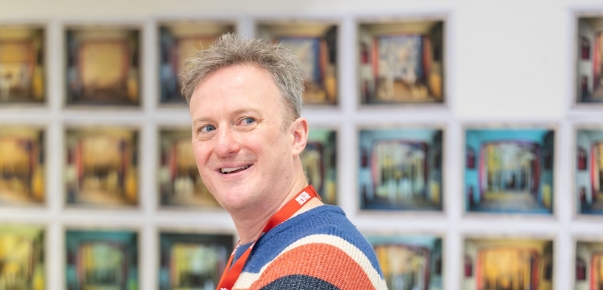New seats, silver tokens and violent controversy over wallpaper...
10 Oct 2011As we head into autumn, we're now at the stage where the demolition work is almost complete and the contractors start to piece things together again. At the weekend Tom Morris and Emma Stenning headed off to Paris to check on the progress of the new seats for the auditorium, being manufactured by Quinette Gallay. As the refurbishment work has progressed, we've been working closely with the architects and seat manufacturers to maximise the capacity in the theatre, whilst not sacrificing comfort and sightlines. At one time in its history, before the gallery was finished up to 1000 people were crammed in to the auditorium - we promise we won't do that, but of course we want as many people as possible to be able to see the work we stage. Anyway, more on the seats in future posts - we've sent Emma off with instructions to take some photos and video so we can share them with you. This post is heading back to the very beginning... The following is an extract about the origins of the theatre from a fascinating book, Bristol Old Vic - The First Ten Years, by Audrey Williamson and Charles Landstone, published in 1957 (You can still buy second hand copies on Amazon if you'd like to read it!):
"[The Theatre Royal] is the oldest theatre in the country. When it was built, King Street, adjacent to the docks, was the centre of the city's life and commerce. The merchants lived in their handsome houses on the other side of the road, or in the neighbouring Queen Square, named after Queen Anne, and boasting a long terraced line of delicate ironwork balconies, in the style of architecture associated with the reign of that monarch. Always the theatre has had to struggle in an atmosphere of storm or stress, and, at the very outset, the idea of a permanent home of drama encountered the fierce opposition of the religious element in the city. Eighteenth-century Bristol had waxed rich on the slave trade, and when public conscience was aroused it found its expression in an excess of puritanism. There had been for the previous forty years a small theatre in what was then the countryside, half a mile outside the town, at the foot of Brandon Hill. "Run by an actor called Powel, who had been a leading man with Garrick at Drury Lane, this building had become too small for the growing theatrical interest of the town [...] A plot of land was acquired in King Street and, despite the vehement local protests, a company of citizens was formed to promote the scheme. Chief among the organisers were Alexander Organ, who was subsequently to become mayor of the town, and Thomas Symons, a solicitor. They gathered around them forty-eight people, who each subscribed the sum of £50. In return these donors each received a silver token which gave them the right to a seat at one performance of every play produced in the theatre. Several of these tickets are still in existence, some of them at the Bristol Museum and Art Gallery. One of the original theatre tokens. "Other money was subscribed, and the theatre eventually cost £5,000 to build. The foundation stone was laid on November 30th 1764, and it was opened on May 30th, 1766. It had been built as a faithful replica of the Drury Lane Theatre of the day; James Paty was the architect and Michael Edkins the decorator. Very little of Edkin's craftsmanship remains today, but Paty's work is almost unaltered. There is still the sunken pit (now converted into stalls), the surrounding horseshoe circles which originally consisted of boxes, the entrances to which can still be seen in the woodwork at their rear. The gallery was added towards the end of the eighteenth century, and the highly decorative ceiling raised to meet it. King Street, late 19th Century - the old entrance to the theatre is on the right. "The original entrance was down a long alleyway between shops and houses, and theatre began at what is now the horseshoe foyer surrounding the dress circle. The conversion of this alleyway into a long entrance passage and the building of bars and offices above the passage are all Victorian additions. When a violent controversy (which reached the national press) arose in 1955 about the pattern of the wallpaper in the entrance passage, the Ministry of Works, as guardians of an 'ancient monument', were careful to point out that they were not concerned, as their jurisdiction began only at the horseshoe foyer."
Luckily, we're not having 'violent controversy' about the style of the interior decorations of the refurbished theatre. The seats and paintwork will be sympathetic to what we believe was the original colour scheme of the theatre - hopefully we'll be able to share some of the ideas with you on this blog. And as work continues on the theatre and back-of-house, we are learning more and more about what the original theatre felt like, from discovering the original level of the pit to digging down into the foundations around the horseshoe.
The foundations of the pit passage, 2011. Photo: Farrows Creative. Sadly, the long entrance passage into the theatre no longer exists. The old frontage of the theatre was replaced in the 1970s with the frontage to the studio which you can see on King Street today. If the passage did still exist, it would pass through our studio theatre, which as you may have read in Bristol Evening Post, is where one of our duty managers, Andrew Stocker, claims he felt a ghostly presence. Perhaps someone is still not happy about the choice of wallpaper in 1955... Words: Matthew Austin.




